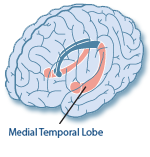There are 3 classifications of memory differentiated by the time lapse between the experience and the recall of that experience. Each type of memory activates a different region of the brain.
Working memory resides in the frontal lobe and is only briefly sustained. This form of memory is commonly referred to as one's attention span and lasts up to one minute before being erased. Trying to dial a telephone number that you have just heard requires the use of working memory.
In a healthy individual, working memory function declines with age in a roughly linear progression.
 Short-term memory resides in the medial temporal lobe and lasts a few minutes to a few weeks before being erased. When you try to recall a conversation or a phone number learned a few minutes to a few weeks ago, the brain areas responsible for short-term memory are activated. Short-term memory resides in the medial temporal lobe and lasts a few minutes to a few weeks before being erased. When you try to recall a conversation or a phone number learned a few minutes to a few weeks ago, the brain areas responsible for short-term memory are activated.
The entorhinal cortex, the tip of the medical temporal lobe, together with the adjacent seahorse shaped area called the hippocampus, are the short-term memory center of the brain. Alzheimer’s disease (AD) generally begins in these areas, which is why the first symptom of AD is usually a decline in short-term memory function.
Long-term memory can last a lifetime. Scientists are not yet certain which brain areas are directly involved in the storage and retrieval of long-term memories. When an adult tries to recall their first love or the name of a school they went to as a child, they are drawing upon this type of memory. |